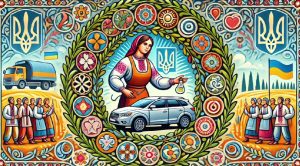Almost ten years on: What happens after #ShiftThePower works?
13 Jun 2025
This blog originally appeared in Alliance magazine.
#ShiftThePower in action: Initial funding of just USD $2,500 has already generated the equivalent of over $30,000 in public good value — and it’s still growing as you read this. A local experiment has grown into something that now needs your insight and response.

Vadym Georgienko, developer of the Citizen Token System
In 2016, I attended the Global Summit on Community Philanthropy in South Africa. It was there that the now-familiar call to #ShiftThePower was born. At the time, it felt like a moral and philosophical imperative — one that resonated deeply with me as someone working in Ukrainian civil society. The idea behind #ShiftThePower inspired me to begin developing a practical mechanism for implementing this vision in real-world conditions.
That’s how the idea behind the Citizen Token System (CTS) began. Not as a platform or product, but as a civic protocol: a way to embed participation, redistribute governance power and create shared ownership of resources in community life.
PB 2.0: Adapting civic participation to wartime realities
After the 2016 Summit, we explored several approaches to putting the #ShiftThePower idea into practice — from community-designed micro-grants to local issue-mapping and gamified engagement formats. But after the full-scale invasion of Ukraine in 2022, we faced a very different set of challenges.
That’s when we launched our first adaptation of the CTS for war-affected communities. With support from the GFCF and in partnership with the Moloda Gromada Foundation, which served as the national coordinator of the piloting process, we focused on transforming one of Ukraine’s most familiar civic tools: participatory budgeting.
We called it PB 2.0, a new form of participatory budgeting where citizens could earn governance tokens through small contributions to the public good, and then use these tokens to vote on how local budgets should be allocated. The model functions as a system of institutionalized recurring cycles, formally integrated with municipal budgeting processes and adaptable to wartime conditions.
The Community Resilience Foundation model: Altering resource flows via self-sustaining circles
Unlike PB 2.0, which focused on integrating citizen decision-making into local budgeting processes, the Community Resilience Foundation (CRF) model explored a different frontier: how communities might build regenerative economic capacity in conditions of prolonged crisis.
The CRF was developed as a model within the broader CTS framework, designed to enable communities to generate added value through self-sustaining circles — with minimal reliance on donor or municipal funding. The structure links citizen contributions to local problem-solving, token-based voting for entrepreneurial initiatives, and the return of capital to restart the cycle again.
In practice, it works in two stages. First, residents address local issues, such as safety, education, or infrastructure, through contributions defined in PB-smart contracts and receive PB-tokens in return. Then, token holders vote on which local entrepreneurs should receive interest-free capital from the community fund. If supported, the entrepreneurs receive backing and commit to returning the funds over time. Token holders often pledge to become their first customers, which reinforces the economic loop.
Over the first 16 months, with just 100,000 UAH (about USD $2,500) in initial capital, the CRF of Rudky launched four complete circles of activity, supporting 22 initiatives and generating over 1.26 million UAH in added value to public goods — all through local decision-making and participation from more than 400 residents.
By altering how resources circulate — and who decides — the CRF model illustrated that community governance can extend far beyond budget allocation. It can shape local economies while preserving its multiplier effect for community benefit.
CTS goes global: Introducing a tested mechanism into global dialogue
Within the broader #ShiftThePower initiative, one of the core ideas has been the interplay between two related work streams: local experimentation and dialogue with funders (Measuring What Matters by Dana Doan and Barry Knight). The assumption is simple: if community-led actors succeed in designing effective solutions, it should activate dialogue with funders and donors about appropriate improvements on their side.
By mid-2023, three distinct CTS models — PB 2.0, CRF and LoT — had already been piloted in Ukraine with measurable results. These efforts clearly belonged to the first stream: local experimentation. An interim online conference hosted by the GFCF that summer brought international visibility to these tools and sparked interest across 17 countries on five continents.
Later that year, in December 2023, the #ShiftThePower Global Summit in Bogotá offered an opportunity to bring the model into a new context. Inna, the Executive Director of the Moloda Gromada Foundation, introduced CTS not as a concept, but as an experiment in live participation. Interested participants received governance tokens for their engagement, which they then used to vote collectively in a simulated decision-making process.
Unlocking local resources: When communities start backing businesses
As we tested the CRF model, we began to notice a pattern that pointed to a deeper shift in community behaviour — one that wasn’t part of our initial expectations. Communities weren’t just allocating resources to solve shared problems. They were also selecting, endorsing and supporting local entrepreneurs, often becoming their first customers. What emerged was more than a financing mechanism. It was the early outline of something we’re still trying to understand fully.
We started referring to it, cautiously, as a “Business-Responsible Society” — a complementary perspective to traditional corporate social responsibility (CSR) models.
Traditional CSR models are based on businesses supporting communities. But in our case, communities began supporting businesses, not because they were asked to, but because they had a say in who gets funding. That sense of ownership turned passive recipients into active customers, co-creators and local champions. Business-Responsible Society doesn’t replace CSR. It complements it by introducing bottom-up dynamics where trust, reciprocity and collective governance make long-term impact possible.
This emerging logic also echoes a recent idea shared by Jenny Hodgson and Eshban Kwesiga in Light in times of darkness: Community philanthropy offers a way forward — to combine the “cold money” of the international donor system with the “warm money” of communities. In our case, this has begun through the CRF model, where donor funds serve as initial regenerative capital that activates and sustains the work with community-based “warm money” through shared governance and participation.
What comes next — and why we need your voice
Everything I’ve described emerged from necessity—during war, displacement, and the fragmentation of institutional aid. But the CTS has grown into something that we believe can be shared, debated, and improved far beyond Ukraine. That’s why we hosted an open online conference on 12 June, with the theme Citizen capital: Solutions from within. We heard from community members, saw the mechanism in action and discussed what shared governance can mean in real life.
The global #ShiftThePower initiative gave us the courage to imagine. Now we invite you to help us refine — and co-create — what comes next. Get in touch if you’d like to discuss further.
By: Vadym Georgienko, developer of the Citizen Token System (CTS), a civic framework for regenerating trust, participation and local economies. From joining the 2016 Global Summit on Community Philanthropy in South Africa in 2016 to field-testing practical mechanisms in war-affected communities, he has been shaping the long arc from vision to implementation.


